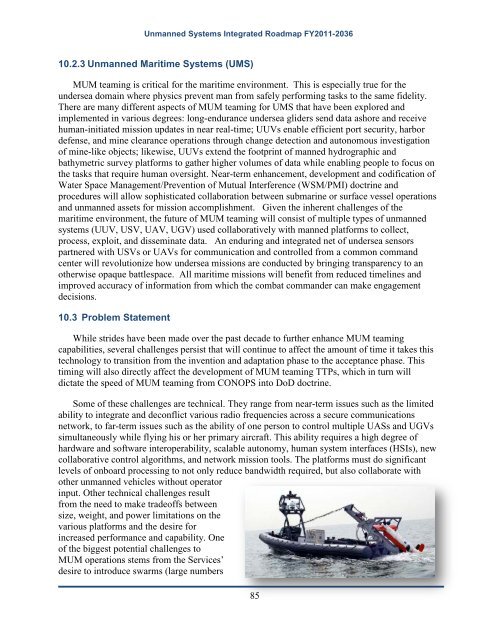Unmanned Systems Integrated Roadmap FY2011-2036 - Defense ...
Unmanned Systems Integrated Roadmap FY2011-2036 - Defense ...
Unmanned Systems Integrated Roadmap FY2011-2036 - Defense ...
Create successful ePaper yourself
Turn your PDF publications into a flip-book with our unique Google optimized e-Paper software.
<strong>Unmanned</strong> <strong>Systems</strong> <strong>Integrated</strong> <strong>Roadmap</strong> <strong>FY2011</strong>-<strong>2036</strong><br />
10.2.3 <strong>Unmanned</strong> Maritime <strong>Systems</strong> (UMS)<br />
MUM teaming is critical for the maritime environment. This is especially true for the<br />
undersea domain where physics prevent man from safely performing tasks to the same fidelity.<br />
There are many different aspects of MUM teaming for UMS that have been explored and<br />
implemented in various degrees: long-endurance undersea gliders send data ashore and receive<br />
human-initiated mission updates in near real-time; UUVs enable efficient port security, harbor<br />
defense, and mine clearance operations through change detection and autonomous investigation<br />
of mine-like objects; likewise, UUVs extend the footprint of manned hydrographic and<br />
bathymetric survey platforms to gather higher volumes of data while enabling people to focus on<br />
the tasks that require human oversight. Near-term enhancement, development and codification of<br />
Water Space Management/Prevention of Mutual Interference (WSM/PMI) doctrine and<br />
procedures will allow sophisticated collaboration between submarine or surface vessel operations<br />
and unmanned assets for mission accomplishment. Given the inherent challenges of the<br />
maritime environment, the future of MUM teaming will consist of multiple types of unmanned<br />
systems (UUV, USV, UAV, UGV) used collaboratively with manned platforms to collect,<br />
process, exploit, and disseminate data. An enduring and integrated net of undersea sensors<br />
partnered with USVs or UAVs for communication and controlled from a common command<br />
center will revolutionize how undersea missions are conducted by bringing transparency to an<br />
otherwise opaque battlespace. All maritime missions will benefit from reduced timelines and<br />
improved accuracy of information from which the combat commander can make engagement<br />
decisions.<br />
10.3 Problem Statement<br />
While strides have been made over the past decade to further enhance MUM teaming<br />
capabilities, several challenges persist that will continue to affect the amount of time it takes this<br />
technology to transition from the invention and adaptation phase to the acceptance phase. This<br />
timing will also directly affect the development of MUM teaming TTPs, which in turn will<br />
dictate the speed of MUM teaming from CONOPS into DoD doctrine.<br />
Some of these challenges are technical. They range from near-term issues such as the limited<br />
ability to integrate and deconflict various radio frequencies across a secure communications<br />
network, to far-term issues such as the ability of one person to control multiple UASs and UGVs<br />
simultaneously while flying his or her primary aircraft. This ability requires a high degree of<br />
hardware and software interoperability, scalable autonomy, human system interfaces (HSIs), new<br />
collaborative control algorithms, and network mission tools. The platforms must do significant<br />
levels of onboard processing to not only reduce bandwidth required, but also collaborate with<br />
other unmanned vehicles without operator<br />
input. Other technical challenges result<br />
from the need to make tradeoffs between<br />
size, weight, and power limitations on the<br />
various platforms and the desire for<br />
increased performance and capability. One<br />
of the biggest potential challenges to<br />
MUM operations stems from the Services’<br />
desire to introduce swarms (large numbers<br />
85

















